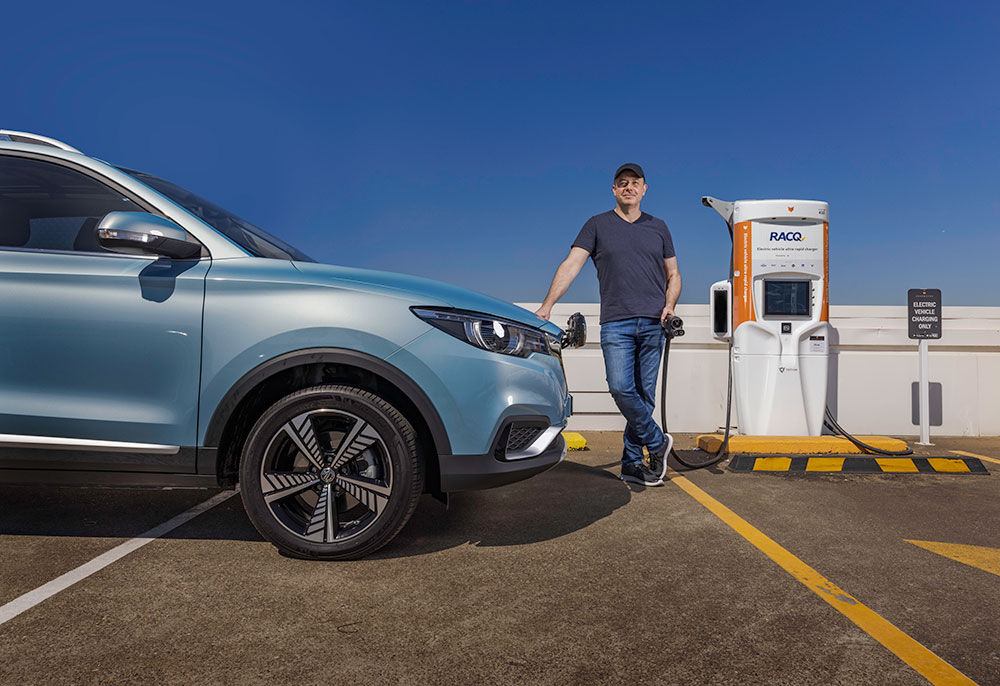How to charge an electric car
Understanding the options for charging an electric car.
.jpg?h=667&iar=0&w=1000&rev=d12aa0776637486ea5f9cdf124686285&hash=800E068067CE9AEDC3A014383772BAAA)
Unlike refuelling an internal combustion vehicle, where your choices are limited mainly to which brand of service station you refill at, battery electric vehicles (BEVs) can be charged either by an AC charger at home or by AC and DC chargers at public charging stations.
Each method has its pros and cons regarding cost and convenience, with the main differentiator being the time it takes to charge.
In general terms, the larger an electric vehicle's (EV) battery, the longer it will take to charge, with the power output of the charging device being the key.
However, battery type/chemistry and whether the vehicle can accept 400V or 800V charging also have an influence.
.jpg?rev=1c37ecc0b67e4da49dcd892afbdf8e3d&hash=A5018572BE194C30FB3B65C145B6274D)
Charging from a wall socket (AC charging)
This is the simplest and most readily available EV charging option since all you need is a power socket and the charging lead supplied with your EV.
A regular household socket delivers 10 amps of electric current, giving a total charging capacity of 2.3 kilowatts.
This means you can charge an EV at a rate of just over 2kW from a standard socket. Given our AC charging workload of roughly 2kW per hour, a 60kWh battery will take about 30 hours to charge from empty.
That equates to about 12km of range for every hour of charging.
In this scenario, if you plug and recharge every night, which most EV owners prefer, you are replenishing only a fraction of the total battery capacity for each charge.
The charging cycle is not consistent, and charging takes longer as the battery gets closer to capacity.
Temperature, be it ambient or battery, will also affect charging time.
.jpg?rev=132bb544d2ff4c47903e60eb9512fe6b&hash=495ED79F940581AED994E72FA51D21A9)
Charging from a home wall box (AC fast charging)
The next level of charging is the home wall box, a piece of charging equipment often installed in household or apartment garages to facilitate faster charging than the 10-amp household socket.
Most EV makers sell wall boxes as an optional accessory, or they can be purchased from independent charging specialists, priced from about $1,000 and $800 for installation.
There are two options with wall boxes, either sticking with standard single-phase power or upgrading to a more powerful three-phase system.
A three-phase circuit provides greater power density than a single-phase circuit at the same amperage, transmitting three times as much power, meaning faster charging times. However installation of three-phase power can be costly and may not be available in your street.
A wall box connected to single-phase power charges at a rate of 7.2kW, which brings EV charging time down significantly and makes it possible to charge most batteries overnight.
Using our standardised 60kWh battery, charging this way will deliver a flat-to-full charge in about eight hours.
That equates to about 42km for every hour of charging.
The next option is to step up to a wall box connected to three-phase power with a charging rate of up to 22kW.
Using our 60kWh battery again, this will deliver a flat-to-full charge in about three hours or about 130km of range for every hour of charging.
Before going to the trouble and expense of installing three-phase power, it’s worth checking the specifications of your EV to ensure it’s able to charge at 21kW from an AC supply since some EVs will only charge at a maximum of 7.6kW AC, even with a 22kW charger.
Most public chargers are currently AC chargers that vary in charging capacity (and speed), so it’s helpful to know in advance if the charger you plan on using is a 7.2kW or 22kW unit.

Charging at a public DC rapid charger (DC fast charging)
DC fast charging is currently the gold standard for charging speed and efficiency. These chargers are increasingly being deployed at major highway rest stops and filling stations to facilitate efficient long-distance EV travel.
The RACQ-sponsored Queensland Electric Super Highway (QESH) is a network of 31 fast-charging sites from Coolangatta to Port Douglas, with 18 more to be added in outback locations. The QESH was constructed by Yurika which is part of Energy Queensland.
DC fast chargers range in capacity from 50kW to 350kW, although not all EVs can charge at this capacity, with the vehicle’s onboard systems moderating how much charge they can accept.
Many late-model vehicles with larger batteries and more sophisticated battery cooling systems, such as the Hyundai Ioniq 5, Tesla Model S and Audi e-Tron, can use the higher power capability of these chargers.
However, many smaller-capacity EVs, including the Nissan Leaf and MG ZS EV, can’t use such high-charging capacity, so while they can be charged on 100kW or 250kW DC fast chargers, they will only charge at a rate of 50kW.
Using our standardised 60kWh battery and the more widely available 50kW DC fast chargers, the battery will be replenished in just over an hour. A one-hour charge will deliver about 300km of driving range.
Constantly charging at high speeds on DC chargers will increase the rate of battery degradation over time.
Home solar and battery system
Another EV charging option attracting growing interest is the use of household solar and a battery storage system.
This is the ultimate solution for those consumers purchasing an EV for environmental reasons. It means they are charging their zero tailpipe emissions vehicle from a zero-emissions energy source.
In Queensland, many home solar power systems will create more electricity than households use. The system’s inverter sends the excess electricity back to the grid when this occurs.
However, because solar feed-in tariffs have fallen considerably in recent years, it’s becoming less economically viable to export excess solar to the grid, given the electricity must be purchased back at night at a higher rate than the feed-in tariff.
This is prompting homeowners to invest in battery storage, which stores the excess energy generated during the day for use in their homes at night, and to charge EVs during the day.
In Queensland’s sunny climate, a solar battery storage system may be full by mid-morning, allowing users to charge their EV for part of the day and still store enough energy to run the household at night.
Like solar installations, the cost of battery storage systems has fallen significantly in recent years, to the point where installing such a system is now a viable option for many Australian households.
Power on with RACQ Roadside Assistance for your EV
Related topics
Things to note
The information in this article has been prepared for general information purposes only and is not intended as legal advice or specific advice to any particular person. Any advice contained in the document is general advice, not intended as legal advice or professional advice and does not take into account any person’s particular circumstances. Before acting on anything based on this advice you should consider its appropriateness to you, having regard to your objectives and needs.
Insurance Products (excluding Travel Insurance) are issued by RACQ Insurance Limited ABN 50 009 704 152 (RACQI) and arranged by its agent, RACQ Distribution Services Pty Ltd (RDS) ABN 35 116 361 650, AFSL 567130 and RDS' authorised representatives (including RACQ Operations Pty Ltd ABN 80 009 663 414, AR No. 234978 (RACQO). Conditions, limits and exclusions apply. RDS and RACQO are in the RACQ group of companies. One of the companies in the RACQ group of companies has a minority shareholding in RACQI.
RDS and RACQO have not taken your personal objectives, circumstances or needs into account when preparing advice regarding insurance products and you will need to consider whether the advice is appropriate for you. Read the Product Disclosure Statement (PDS) and any applicable Supplementary PDS before making a purchase decision on this product. You can also access our Target Market Determinations on this website. RDS receives a commission from RACQI for the policies it arranges. RACQO receives fees paid for services it provides to RDS. Further details about remuneration are available on request prior to purchasing.
Banking and loan products issued by Members Banking Group Limited ABN 83 087 651 054 AFSL/Australian credit licence 241195 trading as RACQ Bank. Terms, conditions, fees, charges and lending policies apply. This is general advice only and may not be right for you. This information does not take your personal objectives, circumstances or needs into account. Read the disclosure documents for your selected product or service, including the Financial Services Guide and the Terms and Conditions, and consider if appropriate for you before deciding.
Except for RACQ Bank, any RACQ entity referred to on this page is not an authorised deposit-taking institution for the purposes of the Banking Act 1959 (Cth). That entity’s obligations do not represent deposits or other liabilities of RACQ Bank. RACQ Bank does not guarantee or otherwise provide assurance in respect of the obligations of that entity, unless noted otherwise.
RACQ Bank subscribes to the Customer Owned Banking Code of Practice which establishes higher standards than the law requires. The Code reflects modern consumer expectations and developments in approaches to issues such as consumer vulnerability, guarantors, and supporting customers through financial hardship. Please read our Customer Owned Banking Code of Practice page for more information.
RACQ Operations Pty Ltd (ABN 80 009 663 414 AR 000234978) and Members Travel Group Pty Ltd (ABN 45 144 538 803 AR 000432492) are acting as an Authorised Representative of the issuer of the insurance, Tokio Marine & Nichido Fire Insurance Co., Ltd. (ABN 80 000 438 291 AFSL 246 548). Any advice set out above is general in nature only, and does not take into account your objectives, financial situation or needs. Before purchasing any travel products, please consider the RACQ Travel Insurance Product Disclosure Statement (PDS) and the Target Market Determinations (TMDs) that apply to these products. Whilst the PDS outlines the Terms and Conditions of these products, the TMDs outline the intended class of customers that comprise the target market for these travel products. This will allow you to consider which products best suit your objectives, financial situation and needs and consider the products appropriateness to your personal circumstances. TMDs also outline matters involving the distribution and the review of these products. The PDS, Supplementary PDS and TMDs for each travel product can be found here.

